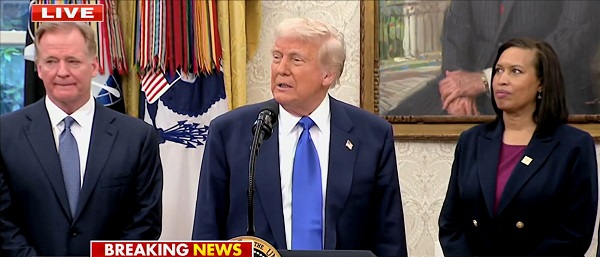Energy
The Flood Of Energy Absurdities Never Slows

 From the Daily Caller News Foundation
From the Daily Caller News Foundation
I often write about absurdities in the energy space, the kinds of stories in which nothing seems to make sense and which result in the wasting of massive amounts of money on rank boondoggles.
Indeed, I maintain an entire Substack focused on what is an amazingly target-rich environment.
Despite enjoying such a wealth of absurd potential content, I found myself suffering from a bit of writer’s block Tuesday morning — thanks in large part to all the breaking news about debates and attempted assassinations permeating our society in recent days. But that was before two gloriously absurd stories popped into my in-box.
The first of these absurdities comes to us from the ritzy Massachusetts island of Nantucket, where debris from one of President Joe Biden’s vaunted offshore wind monstrosities — speaking of rank boondoggles — was found littering the beaches in recent days. The Nantucket Current reports that the debris, apparently hard fiberglass material from a broken blade, originates from the Vineyard Wind 1 offshore project, whose first ten massive turbines were activated less than a month ago.
So much for that advertised 30-year life, huh?
The operators of Vineyard Wind said the debris is the result of an “offshore incident” in which a blade suffered damage. The company also characterized the debris as “non-toxic fiberglass fragments,” adding that they are “not hazardous to people or the environment.”
No word from the company on the nature of this “incident,” or on how frequently Nantucket residents can expect such litter from their 62 government-subsidized, 850-feet-tall turbines (almost the height of the Eiffel Tower) and blades to wash up on their beaches. But the fact that the first “incident” came during the first month of operations was not exactly encouraging.
Then the story got even worse for Vineyard Wind: Boston.com reported Tuesday that Nantucket officials made the decision to close the beaches to public access due to dangers from what they called “floating debris and sharp fiberglass shards” that were part of the debris. Worse still, the Federal Bureau of Safety and Environmental Enforcement announced late Tuesday the development’s operations have been “shut down until further notice” due to the safety hazards to the public.
Despite the inconvenience and potential hazards caused by Biden’s offshore wind boondoggles, we can be sure that Nantucket residents will enjoy paying their future power bills that are being inflated by the power-provision guarantees deftly negotiated by their state leaders. It is, after all, a small price to pay for such a glorious virtue signaling opportunity.
The next story comes to us from a report at LiveScience.com detailing a new study predicting that earthquakes will now be caused by the all-knowing, all-seeing, all-causing, all-powerful boogeyman we refer to as “climate change.” No, really, I swear I’m not making that up. Promise.
It is a real report, headlined, “Will we have more earthquakes because of climate change?”
Naturally, the story suggests this will be the case. What else would a good climate alarmist say? It is a requirement for researchers to blame literally every bad thing in our lives on climate change because, if you don’t, you won’t get that next government grant, now, will you?
That is the game. It has been the game for 30 years now, and many believe the net effect has been the increasing corruption of what we call “science.” The raising of outlandish claims such as this in glaring headlines or by hyperventilating weather people on our local news channels is exactly why a constantly rising percentage of the population holds the field of climate “science” in contempt.
One X user who tweeted this story out said: “I miss the days when we used to blame witches.” That is really funny. I wish I had thought of it first.
I know this frustrates all the alarmists out there, but I am just the messenger here. If you want the winds of public attitudes to ever shift in your direction, you are going to have to stop spreading ridiculous nonsense like this. All your cynical efforts to raise alarm are backfiring, and it could not happen to a more deserving bunch of people.
David Blackmon is an energy writer and consultant based in Texas. He spent 40 years in the oil and gas business, where he specialized in public policy and communications.
Automotive
Federal government should swiftly axe foolish EV mandate

From the Fraser Institute
Two recent events exemplify the fundamental irrationality that is Canada’s electric vehicle (EV) policy.
First, the Carney government re-committed to Justin Trudeau’s EV transition mandate that by 2035 all (that’s 100 per cent) of new car sales in Canada consist of “zero emission vehicles” including battery EVs, plug-in hybrid EVs and fuel-cell powered vehicles (which are virtually non-existent in today’s market). This policy has been a foolish idea since inception. The mass of car-buyers in Canada showed little desire to buy them in 2022, when the government announced the plan, and they still don’t want them.
Second, President Trump’s “Big Beautiful” budget bill has slashed taxpayer subsidies for buying new and used EVs, ended federal support for EV charging stations, and limited the ability of states to use fuel standards to force EVs onto the sales lot. Of course, Canada should not craft policy to simply match U.S. policy, but in light of policy changes south of the border Canadian policymakers would be wise to give their own EV policies a rethink.
And in this case, a rethink—that is, scrapping Ottawa’s mandate—would only benefit most Canadians. Indeed, most Canadians disapprove of the mandate; most do not want to buy EVs; most can’t afford to buy EVs (which are more expensive than traditional internal combustion vehicles and more expensive to insure and repair); and if they do manage to swing the cost of an EV, most will likely find it difficult to find public charging stations.
Also, consider this. Globally, the mining sector likely lacks the ability to keep up with the supply of metals needed to produce EVs and satisfy government mandates like we have in Canada, potentially further driving up production costs and ultimately sticker prices.
Finally, if you’re worried about losing the climate and environmental benefits of an EV transition, you should, well, not worry that much. The benefits of vehicle electrification for climate/environmental risk reduction have been oversold. In some circumstances EVs can help reduce GHG emissions—in others, they can make them worse. It depends on the fuel used to generate electricity used to charge them. And EVs have environmental negatives of their own—their fancy tires cause a lot of fine particulate pollution, one of the more harmful types of air pollution that can affect our health. And when they burst into flames (which they do with disturbing regularity) they spew toxic metals and plastics into the air with abandon.
So, to sum up in point form. Prime Minister Carney’s government has re-upped its commitment to the Trudeau-era 2035 EV mandate even while Canadians have shown for years that most don’t want to buy them. EVs don’t provide meaningful environmental benefits. They represent the worst of public policy (picking winning or losing technologies in mass markets). They are unjust (tax-robbing people who can’t afford them to subsidize those who can). And taxpayer-funded “investments” in EVs and EV-battery technology will likely be wasted in light of the diminishing U.S. market for Canadian EV tech.
If ever there was a policy so justifiably axed on its failed merits, it’s Ottawa’s EV mandate. Hopefully, the pragmatists we’ve heard much about since Carney’s election victory will acknowledge EV reality.
Daily Caller
Trump Issues Order To End Green Energy Gravy Train, Cites National Security


From the Daily Caller News Foundation
By Audrey Streb
President Donald Trump issued an executive order calling for the end of green energy subsidies by strengthening provisions in the One Big Beautiful Bill Act on Monday night, citing national security concerns and unnecessary costs to taxpayers.
The order argues that a heavy reliance on green energy subsidies compromise the reliability of the power grid and undermines energy independence. Trump called for the U.S. to “rapidly eliminate” federal green energy subsidies and to “build upon and strengthen” the repeal of wind and solar tax credits remaining in the reconciliation law in the order, directing the Treasury Department to enforce the phase-out of tax credits.
“For too long, the Federal Government has forced American taxpayers to subsidize expensive and unreliable energy sources like wind and solar,” the order states. “Reliance on so-called ‘green’ subsidies threatens national security by making the United States dependent on supply chains controlled by foreign adversaries.”
Dear Readers:
As a nonprofit, we are dependent on the generosity of our readers.
Please consider making a small donation of any amount here.
Thank you!
Former President Joe Biden established massive green energy subsidies under his signature 2022 Inflation Reduction Act (IRA), which did not receive a single Republican vote.
The reconciliation package did not immediately terminate Biden-era federal subsidies for green energy technology, phasing them out over time instead, though some policy experts argued that drawn-out timelines could lead to an indefinite continuation of subsidies. Trump’s executive order alludes to potential loopholes in the bill, calling for a review by Secretary of the Treasury Scott Bessent to ensure that green energy projects that have a “beginning of construction” tax credit deadline are not “circumvented.”
Additionally, the executive order directs the U.S. to end taxpayer support for green energy supply chains that are controlled by foreign adversaries, alluding to China’s supply chain dominance for solar and wind. Trump also specifically highlighted costs to taxpayers, market distortions and environmental impacts of subsidized green energy development in explaining the policy.
Ahead of the reconciliation bill becoming law, Trump told Republicans that “we’ve got all the cards, and we are going to use them.” Several House Republicans noted that the president said he would use executive authority to enhance the bill and strictly enforce phase-outs, which helped persuade some conservatives to back the bill.
-

 MAiD2 days ago
MAiD2 days agoCanada’s euthanasia regime is already killing the disabled. It’s about to get worse
-

 Daily Caller16 hours ago
Daily Caller16 hours agoUSAID Quietly Sent Thousands Of Viruses To Chinese Military-Linked Biolab
-

 Alberta13 hours ago
Alberta13 hours ago‘Far too serious for such uninformed, careless journalism’: Complaint filed against Globe and Mail article challenging Alberta’s gender surgery law
-

 Censorship Industrial Complex23 hours ago
Censorship Industrial Complex23 hours agoCanadian pro-freedom group sounds alarm over Liberal plans to revive internet censorship bill
-

 Fraser Institute1 day ago
Fraser Institute1 day agoBefore Trudeau average annual immigration was 617,800. Under Trudeau number skyrocketted to 1.4 million from 2016 to 2024
-

 International2 days ago
International2 days agoChicago suburb purchases childhood home of Pope Leo XIV
-

 Daily Caller2 days ago
Daily Caller2 days ago‘I Know How These People Operate’: Fmr CIA Officer Calls BS On FBI’s New Epstein Intel
-

 Economy1 day ago
Economy1 day agoThe stars are aligning for a new pipeline to the West Coast


